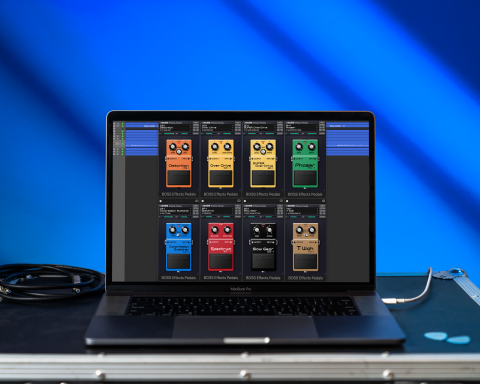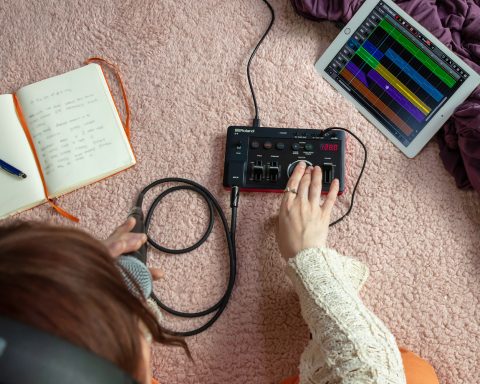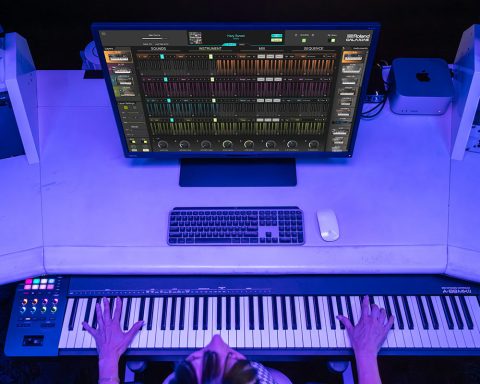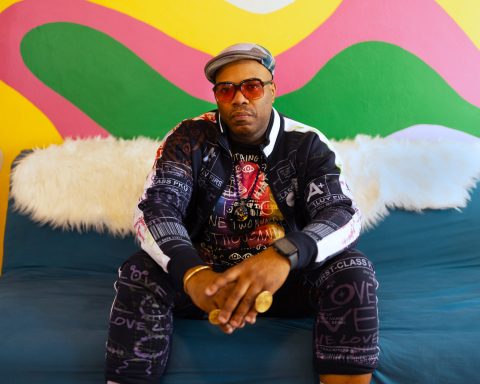The Roland TR-808 and TR-909 are two of the most iconic drum machines in music history. Each machine is responsible for creating the rhythmic and sonic backbone of two of the most influential genres of music in the last 40 years: house (909) and hip-hop (808). In hip-hop music, the term 808 has become synonymous with the long bass drum sound that was first heard on the original TR-808.
A Pair of Rhythm Legends
Thousands of variations of this sound were born over the last 30 years. Take a snapshot of Billboard charts for the past decade. Most of the songs in the Top 10 at any moment most likely contain some version of the 808 bass drum sound in their production. As house and techno music evolved into various forms of EDM, the 909 sound also became a source of legend.
Both drum machines were revolutionary when they first hit the market. The TR-808 was one of the first fully programmable drum machines that used analog synthesis. As for the 909, it was the first drum machine to combine analog synthesis with digital sampling and MIDI. Tadao Kikumoto, the mastermind behind the TR-808, TR-909, and TB-303, wasn’t aware of the popularity of these instruments until nearly a decade after their release.
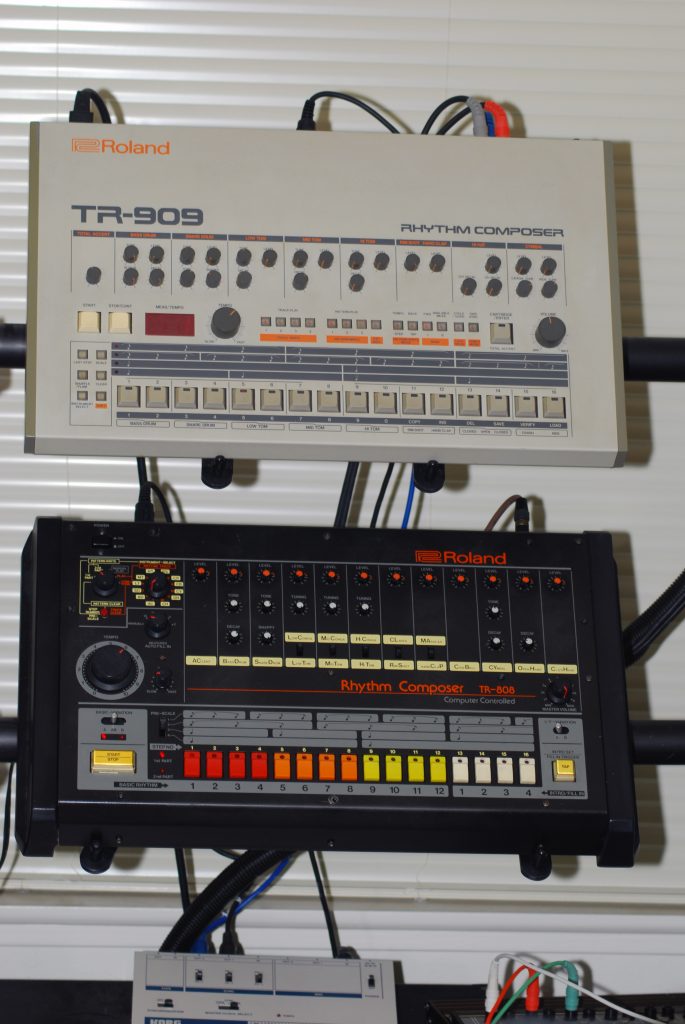
Today’s Music Production Style
In today’s modern music production world, many music producers use digital audio workstations (DAWs) and virtual software instruments (VSTs) to create music. This shift from analog recording and instruments to digital has defined the sound of the last 20 years.
Yet, in recent years producers have rediscovered the warmth of analog machines. As a result, the popularity of the TR-808 and TR-909 found a resurgence. Roland answered the call by releasing the Boutique series of synthesizers and drum machines in 2017. This series featured the TR-08 and TR-09: essentially recreations of the classic TR-808 and TR-909 drum machines.
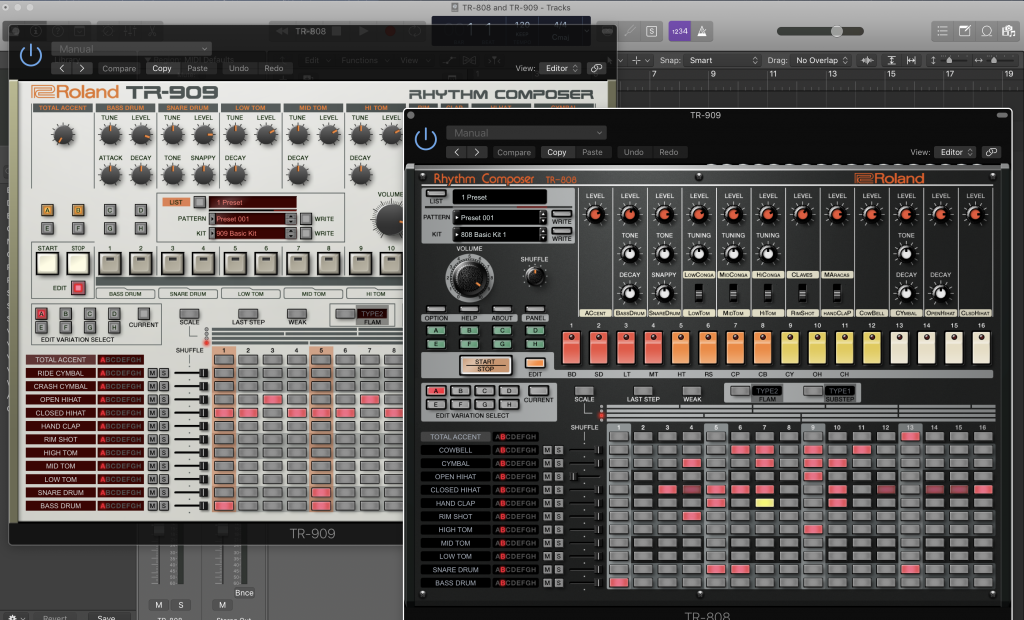
The Power of the Plug-in
Roland has gone a step further and created plug-in versions of these machines which are available through Roland Cloud. Producers no longer need to spend hours searching through sound libraries, sample packs, and elsewhere to find the perfect drum sound. They can now use these classic machines as a foundation to create custom drum sounds.
When looking at the layout for both the TR-909 and TR-808, you can see how the template for modern drum programming grew. The organization of each divides into the following sounds: Bass Drum, Snare Drum, Low Tom, High Tom, Mid Tom, Cymbal (the TR-909 features both a crash and a ride sound), Closed and Open Hat, Rim Shot, Clap, and Cowbell (this sound is only on the TR-808).
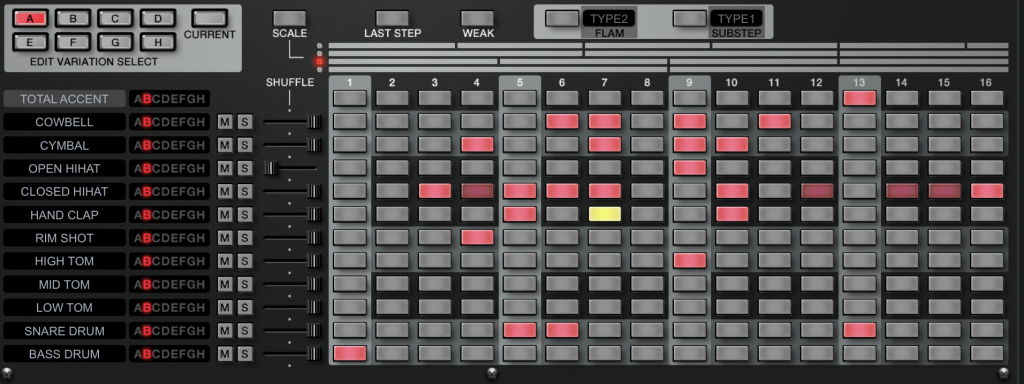

Customize Your Sound
Each one of these sounds is editable using the various instrument edit knobs such as Attack, Decay, Tone, Tune, Level, Snappy, Gain, and Total Accent. While not every instrument has access to the same parameters (snare sounds are the only sound with the snappy knob), there is still a large amount of flexibility in how you can design each drum sound.
The TR-808 VST comes with ten different preset kits and the TR-909 comes with nine. There are two approaches to creating drum sounds using these plug-ins. One way is to tweak each sound using the instrument edit knobs and then save your new kits as presets by clicking the “Write” button.
Another way is to record each sound as audio and then edit them using audio effects and plug-ins inside your DAW. Let’s unpack both methods and explore the sound design possibilities that are available by using these instruments.


Resampling Method: TR-808
Using the TR-808, I can select the “Option” button and click “Drag & Drop Pattern as Audio” to record a pre-programmed pattern into my DAW. For an example of how to resample the audio from the TR-808, I’ll do a simple pattern of quarter notes for three sounds: bass drum, snare drum, and hat.
I used the 808 Long BD preset for the original sounds and now that I have them as audio files I can edit each one individually. Here are the original drum sounds:
For the bass drum, I used an equalizer (EQ) to cut all frequencies above 1k HZ and boosted the frequency at 32HZ. This made the sound a little more mellow and less punchy. I then added a compressor to boost the signal and add some more attack. The final step was to add a bit of distortion which users you can do with saturation or overdrive effects. A great technique for manipulating 808 samples is modulating the pitch and creating unique basslines.
For the snare drum, I also used EQ and compression to manipulate the sound. As for the EQ, I cut most of the frequencies below 100HZ. Then, I boosted frequencies at 200 Hz and 6kHz. For the compressor, I turned the threshold down to -15 DB and set the attack rate pretty high. The original signal had some buzzy noise in the higher frequencies. To address this, I used a gate to reduce the noise but keep the crispy snap of the snare.
For the hats, I used a low-pass filter to take out all the frequencies above 3KHz, and then a compressor to boost the signal. I also added a light bit of distortion to give it a bit of edge.
Here’s a demo beat using my newly edited sounds:
Resampling Method: TR-909
To resample the TR-909 I used the same process of recording a bass drum, snare drum, and hat sample using the “Low Tuned” preset.
After recording the audio, I wanted to make the drums sound darker and weirder. To achieve this, I used an EQ to boost the frequencies on the bass drum around 40Hz. I then used a gate to take away some of the noise from the signal and a compressor to boost the low end. To top it off I used a flanger to add an extra textural element to the sound.
For the snare, I used an EQ to cut frequencies below 43Hz and above 3KHz. I then added some compression and a flanger to turn the sound into a more metallic snare with less of the white noise from the original sample.
For the hats, I went completely weird and added chorus, ring modulator/frequency shifter, and bit reduction. In addition, I used EQ to cut frequencies below 100Hz and I did another cut at 6KHz. This turns the hats into a sort of weird digital pluck. The last step was adding reverb to all of the sounds. All together the manipulated 909 sounds created the perfect texture for a dark techno beat.
Custom Kit: TR-808 and TR-909
Another way we can make sounds with the TR-808 and 909 plug-ins is by creating preset kits. By simply adjusting the parameters of the individual drum instruments you can completely transform the sound of any of the preset kits. For example, here’s a pattern from the 909:
Here’s the same pattern but now I’ve used the Tune knob to turn the bass drum frequency down and I turned the Level knob all the way up. I also changed the tuning of the snare and turned the Snappy knob all the way up. For the hat, I turned the Decay down slightly and now the kit sounds completely different:
If I like the way this new kit sounds I can easily save it by going into the kit window and selecting “Write.” Then, I rename it however I want to describe the kit. There are 128 kit slots available and it’s easy to delete, load, or rename the kits.
This process of saving patterns you’ve created using the step sequencer is the same on both the TR-909 and 808. Below you can hear an example of preset 009 on the 808 in its original form and then slightly manipulated using the instrument knobs:
The TR-808 and TR-909 are genre-defining instruments that are now available at the click of a button. Roland Cloud allows access to these iconic instruments as well as over 50 amazing software instruments that celebrate Roland’s past and future.



